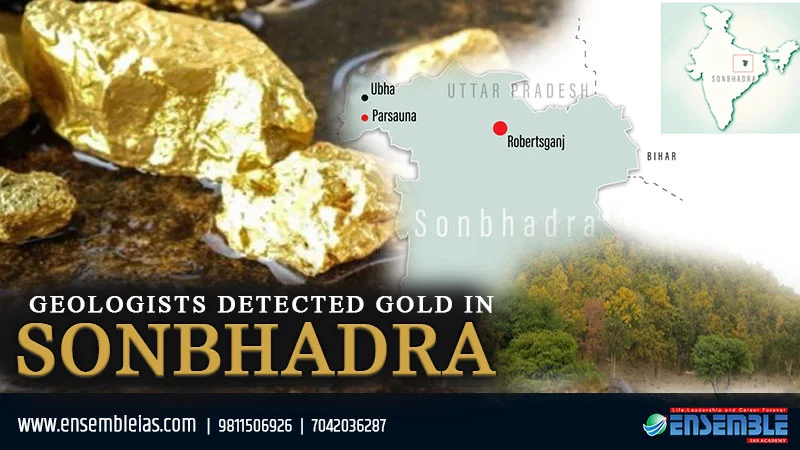 How geologists detected gold in Sonbhadra, estimated its value
How geologists detected gold in Sonbhadra, estimated its value
GSI director general M Sridhar said that the GSI Northern Region carried out exploration in 1998-99 and 1999-2000. The results, however, were not encouraging enough to suggest major resources for gold in Sonbhadra.
In a recent statement (The Indian Express, February 23), the Geographical Survey of India (GSI) provided estimates for the amount of gold that can be extracted from a site in Sonbhadra district of Uttar Pradesh. The probable resource is 52,806.25 tonnes of ore, with an average grade of 3.03 grams per tonne, which means the total gold that can be extracted is 160 kg, it said. The statement came after news reports stated that the gold available is 3,350 tonnes; the GSI clarified that its estimates are 160 kg.
What is this site with ore?
It is near a village called Mahuli, around 70 km from Sonbhadra district’s headquarters of Roberstganj, and just 10 km from Jharkhand. The land is mainly forest area and inhabited mostly by tribals and members of backward classes. Locals said stories of gold underground have been passed down generations, giving rise to the name Sonpahari, the hill where the reserves have been estimated.
The site is part of the Mahakoshal region that includes parts of UP, Madhya Pradesh and Jharkhand. It is known to be potentially mineral-rich, said GSI Lucknow director Ghanshyam Tiwari. “This is something we also know through the geological map we keep updating, and that is why this whole Mahakoshal region has always interested us. We keep studying the rocks here and search for potential mineral reserves. That is what exactly what the GSI is for,” he said.
How long has the GSI known about the ore and its mineral content?
The GSI Northern Region carried out exploration in 1998-99 and 1999-2000, GSI director general M Sridhar said. The results, however, were not encouraging enough to suggest major resources for gold in Sonbhadra. “We found that there is an estimated resource of 52,806.25 tonnes of ore with 3.03 grams per tonne gold. This information was not significant for us as we know that extracting 160 kg gold, or even less, from more than 52,000 tonnes can cost a lot,” said Ashish Kumar Nath, director & PRO, GSI Central Headquarters.
The GSI compiled a report but did not forward it to the state government at the time. It submitted the report in 2019, following an amendment to the Mines and Minerals (Development and Regulation) Act in 2015. “(It) had a clause that we have to share all our reports with the state government. As we had thousands of such reports, this particular report was sent to the UP government last year,” said Ashish Kumar Nath, director & PRO, GSI Central Headquarters.
How does the GSI arrive at such estimates?
Two basic processes are involved — a study of rocks, and drilling of the ground. Laboratory analysis of the rocks indicates the possibility of these containing a particular mineral, in this case gold, said Tiwari, the GSI Lucknow director.
Another indicator is the age of the rocks, which is determined by radiometric dating processes. For high possibility of containing such metals and minerals, the rocks need to be at least 700 million years old, Tiwari said, while also citing exceptions. “The rocks in Sonbhadra are in the Mahakoshal region and from the Proterozoic era, which started 2,500 million years ago,” Tiwari said.
The GSI drilled the ground at some 30 places between 1998 and 2000, before compiling the report. This eventually provides a three-dimensional image of the area, which is necessary for determining the quality of the resource and the amount available.
Will it be worthwhile to extract the gold from the ore?
The GSI classifies ore into categories based on the viability of extraction, which is determined from density. Tiwari said the gold ore found in Sonbhadra is in the “economic” category, which means that extraction will cost less than the cost of the gold that is extracted. The cost of extraction also depends on the grade of gold; the higher the gold concentration, the easier its extraction.
At the same time, GSI officials pointed out that the findings are two decades old and the possible gold present is just 160 kg. GSI director & PRO Nath said they have thousands of such findings, and this particular report was never a priority.
So, what happens to the ore now?
Once the GSI gives an estimate, the state government conducts an auction and the winner undertakes the extraction. UP government officials said that before e-auctioning, a team of officials from the state mining department and the district administration have been asked to conduct a survey of the area and identify the land containing ore, by superimposing GSI’s geological maps on khasra maps from revenue records.
District Magistrate (DM) S Rajalingam said that reserves of other minerals — andalusite, potash and iron ore — have been estimated in various parts of Sonbhadra. A preliminary survey also suggested a possibility of uranium deposits, he said.
Source: Indian Express | Written by Avaneesh Mishra
For more details : Ensemble IAS Academy Call Us : +91 98115 06926, +91 7042036287
Email: [email protected] Visit us:- https://ensembleias.com/
#india #prime_minister #narendra_modi #government #policy #blog #current_affairs #daily_updates #free #editorial #geographyoptional #upsc2020 #ias #k_siddharthasir #ensembleiasacademy #sonbhadra #gold #ensembleiasacademy #GSI #wednesdywisdom #wednesdaymotivation #delhi #current_affairs #editorial #upsc2020 #ias #k_siddharthasir



